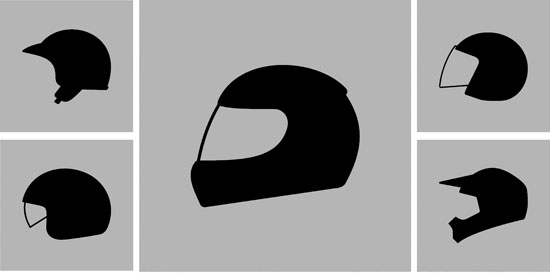Helmets, head impact protection, and comparative fault
A primer on head injury and helmet investigations; helmets are often part of comparative-fault arguments advanced by defendants
Mechanical devices have been used since the time of antiquity to protect the head from direct impact. Most early helmets were crude shells with little or no padding that were effective against projectiles and penetrating objects. A gladiator’s battle helmet is a good example. Early in the 1900’s, when automobiles, motorcycles and aviation were in their infancy, padded leather helmets became fashionable, although their protective ability was limited. In the 1950’s and 1960’s, biomechanical scientists started to understand the impact loads that could cause skull fractures and brain injuries. With this understanding, instrumentation and tests were devised to quantify head impact exposure and helmet performance. This testing spurred the development of the modern helmet. A modern helmet has energy-absorbing and impact-distributing properties to mitigate lacerations, contusions, skull fractures and brain injuries.
Modern helmet design
The modern helmet is constructed of a hard outer shell to resist penetration and an inner liner to absorb energy and spread impact forces over a larger area. The combined effect of the functional layers reduces the injurious forces applied to the head by lengthening the total time of impact. A strap or restraint system keeps the helmet on the head where it is needed. Most helmets also have a comfort liner immediately adjacent to the head.
For helmets that are designed to protect the user from severe impacts, such as motorcycle, bicycle and equestrian helmets, the most common material used to construct the liner is expanded polystyrene (EPS). Energy-absorbing liners for these helmets are good for one serious impact only. Once struck, the energy-absorbing material will have been crushed, cracked and deformed; the material will no longer adequately absorb energy. Some sport helmets, such as those for hockey and football, are designed for multiple impacts (albeit they are designed to manage lower energy impacts). The energy-absorbing material of these helmets recovers from impact and does not need to be replaced.
Performance standards
Technical performance standards have been established through the consensus of biomechanical and helmet experts. Specific standards have been developed for each type of helmet. Motorcycle helmets, for example, must adhere to different performance criteria than bicycle helmets or hockey helmets. The most common motorcycle helmet certification standards are the United States Department of Transportation (DOT) and the Snell Memorial Foundation standards. For bicycle helmets, the most common standards are administered by the U.S. Consumer Product Safety Commission (CPSC) and the Snell Memorial Foundation.
Novelty motorcycle helmets come up frequently in forensic helmet investigations. A novelty helmet looks very slim fitting because it does not have an energy-absorbing liner. Do not mistake comfort foam for an energy-absorbing liner. Novelty helmets will not meet an impact protection standard and are illegal in jurisdictions where helmets are required by law. These helmets are typically used for their visual appeal rather than their functional impact protection.
Users may purchase a sticker closely resembling a certification label and place it on the helmet to mislead law enforcement that their helmet meets the required standards. In May 2013, changes were made to the Federal Motor Vehicle Safety Standard, FMVSS 218, requiring improvements to the Department of Transportation certification label that the DOT feel will deter attaching misleading helmet labels.
Injury mitigation
The development of the modern helmet is a biomechanical engineering success story. Modern helmets with energy-absorbing liners are very effective at reducing the incidence of head injuries. Dubious claims that helmets increase other injuries are not supported by reliable scientific investigations and literature.
Different helmet makes, models and styles provide different head coverage and, as a result, the injury mitigation varies depending on the point of impact and the coverage area of the helmet. A full-face helmet can also protect the user from facial impacts. Helmets are least effective when the impact is to the edge of the helmet.
Mild traumatic brain injury (MTBI) or concussion is a topic that receives considerable attention in both litigation and in the press. Helmets reduce the transmission of forces applied to the head that cause MTBI; however, even a properly fitted and properly worn helmet can allow the transmittal of forces that will result in MTBI symptoms in a portion of the population. Helmets are most effective at preventing serious brain injuries and skull fractures. The most recent research indicates they may reduce, but are not capable of preventing MTBI.
Even a certified helmet can only perform well when worn properly. When a helmet fits poorly or is not fastened securely with the chin strap, it can shift during usage resulting in reduced visibility or sub-optimum protection. Worse, the helmet can be ejected from the head during impact, resulting in a serious injury.
Forensic investigation
A helmet inspection by an expert can identify whether a helmet has been subjected to an impact and can determine the direction and magnitude of the impact. A visual helmet inspection may be sufficient to identify and document the physical evidence. In some cases, the energy-absorbing liner will need to be removed from the helmet for examination; this is a more involved procedure. Tests can be conducted to evaluate the effect of appropriate helmet fit, chin strap usage and helmet retention. An associated biomechanical investigation can identify the range of injuries expected given the physical damage to the helmet. An expert inspection can also identify marks that are fraudulently placed on a helmet to appear like impact evidence.
Comparative fault
The scientific evaluation of injury outcome considering contributory negligence is often evaluated in a forensic helmet investigation. In many cases, an investigation reveals that the use of a helmet would have reduced the magnitude of the head injury. When a helmet is not worn, impact loads to the head are much higher and, as a result, injuries are much more severe than they would have been had a helmet been worn; however, a high severity impact can overwhelm the protective capabilities of a helmet and still result in an injury.
IIHS stats say fatalaties reduced
The Insurance Institute for Highway Safety (IIHS) reports that unhelmeted motorcycle riders are three times more likely to suffer a traumatic brain injury in a crash than helmeted riders and that helmets reduce motorcycle-crash fatalities by 37 to 42 percent. The IIHS also reports that bicycle helmets reduce head-injury risk by an estimated 50 percent.
Despite these convincing figures, many people prefer not to wear helmets, and helmet laws vary greatly from state to state.
No states require adult bicycle helmet usage, but some have helmet laws applying to minors. Most states have no bicycle helmet law at all, although there are many city bylaws that require helmets for some or all bicyclists.
Motorcycle helmets were mandatory for all riders in almost every state in the early 1970’s, but then the federal government eased pressure on helmet use legislation and laws in many states were weakened or repealed. Today, only 19 states and the District of Columbia have helmet laws covering all riders, and three states have no motorcycle helmet requirements. The IIHS reports that, historically, motorcycle helmet laws have dramatically increased helmet usage, and helmet usage has significantly reduced rider deaths and injuries.
Craig A. Good

Craig A. Good is the president and senior consultant of Collision Analysis, an automotive forensic consulting firm with offices in Marina del Rey, CA, and Calgary, AB, Canada. He received a Ph.D. in Mechanical Engineering specializing in Injury Biomechanics. He has been the recipient of several prestigious research awards and scholarships throughout his academic career. He is also the holder of a U.S. and a European seat-belt patent.
Copyright ©
2025
by the author.
For reprint permission, contact the publisher: Advocate Magazine


